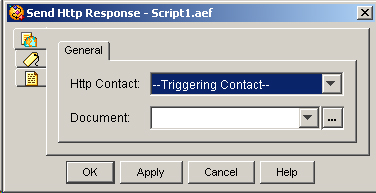Send Http Response Step
Use the Send Http Response step to send a document to a browser.
Note | You should upload all documents to the Document repository and reference them using the expression language command DOC[filename]. Storing documents in the repository allows them to be synchronized across all Cisco Unified CCX servers in the cluster and included in server backups. |
The document, which is stored in a document variable, must be ready to be sent. You may, for example, place the Keyword Transform Document step before this step in your script to update the document with dynamic information before it is sent to a user.
A script should use only one of the following steps from the Http Contact palette to respond to an HTTP request:
-
Http Redirect
-
Http Forward
-
Send Http Response
If you use the Send Http Response step, you should not use either a Http Redirect or Http Forward step in the same sequence within a script, because using any one of these three steps moves the Http Contact into a final state when the response is returned back to the browser. The script cannot attempt to send another response back because one has already been sent. If, however, a script has some conditional logic, you can use one of these three steps in one condition and another in another condition.
Note | You can also use the Reject and Terminate steps from the Contact palette as responses to an HTTP request. For more information, see Contact Steps. |
Figure shows the customizer window for the Send Http Response step.

The following table describes the properties of the Send Http Response customizer window.
|
Property |
Description |
|---|---|
|
Http Contact |
Contact variable that triggers the execution of the step. Default is Triggering Contact, unless another contact is specified. |
|
Document |
Variable or expression indicating the location of the document to be sent. |